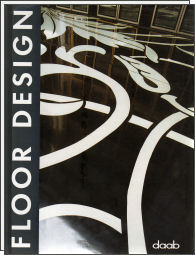 A floor covering consists either of carpet, wood, or tiles? Try again! In addition to the classic materials and techniques, Floor Design also presents the modern ones. It shows that the design of a floor is a demanding construction task that decisively influences the effect of a room. A floor covering consists either of carpet, wood, or tiles? Try again! In addition to the classic materials and techniques, Floor Design also presents the modern ones. It shows that the design of a floor is a demanding construction task that decisively influences the effect of a room.
While classics such as terrazzo floors or mosaics experience a renaissance, time-tested materiale have been given a "complete overhaul": Linoleum, which was stuck with the thankless association of a hospital atmosphere, has been given a new, trendy color scheme by the renowned designer Marcel Wanders and used for the posh Lute Suites. Colors and ornaments are conspicuous as the current means of design: Floors can be created in all of the desired colorations, patterns, and ornaments with epoxy resin and pigments. But even the simple monochromaticity of a floor can captivate the observer, as shown in the project of the Kindertagesstàtte Oberschóneweide day-care center by Behles+Jochimsen. This effect can be increased by including walls and ceilings in a uniform color concept, as demonstrated in the House with Apiary by Hertl.Architekten. The Museum of the Archdiocese by HSH Architekti combines the various materials and allows the floor to become a guide that separates the individuai functions from each other in a subtle manner.
The great classic among the floor coverings - the carpet - had long removed itself from the flair of dusty carpeting and become a true design object: Fine raw materials, brilliant colors, sophisticated techniques, and prints in comic style decorate the small and large exemplars. In its collections, the Ruckstuhl company even integrates wood elements and zippers that include the user in the design process.
Designs like the Roof Structure in Bozen by Einzigart Architekten and the Styleparklounge by Jlirgen Mayer show that the "two-dimensional" floor can also be viewed as three-dimensional: A wood floor merges into the ceiling and wall here, and the floor folds up into seating and displays there as the transitions blend.
The projects that are presented here show that a floor is more than just a surface that serves the other parts of the building as a foundation. It is an object of design that is worth considering on its own. |
 La copertura di un pavimento consiste solo di tappeti, legno o piastrelle? Nulla di più sbagliato! Floor Design presenta fianco a fianco tecniche e materiali classici e moderni, dimostrando che la modellazione di un pavimento è un compito costruttivo che richiede estrema attenzione e che influenza considerevolmente l'effetto spaziale. La copertura di un pavimento consiste solo di tappeti, legno o piastrelle? Nulla di più sbagliato! Floor Design presenta fianco a fianco tecniche e materiali classici e moderni, dimostrando che la modellazione di un pavimento è un compito costruttivo che richiede estrema attenzione e che influenza considerevolmente l'effetto spaziale.
Mentre alcuni classici come i pavimenti alla veneziana o in mosaico sono oggetto di riscoperta, altri materiali ben collaudati subiscono un completo rinnovamento: il linoleum, tradizionalmente penalizzato da un'ingrata associazione con atmosfere ospedaliere, viene provvisto di nuovi variopinti schemi cromatici grazie all'opera del celebre designer Marcel Wander, e impiegato per le nobili Lute Suites. Colori e ornamenti hanno il predominio assoluto tra gli attuali strumenti creativi: tramite pigmenti e resine epossidiche, è possibile allestire un pavimento con ogni colorazione, ornamento o campionatura desiderata. Ma anche la semplice monocromaticità può incantare l'osservatore, come dimostra il progetto dell'Asilo Nido di Oberschóneweide di Behles+Jochimsen.
L'effetto si intensifica mediante il coinvolgimento delle pareti e del soffitto in un concetto cromatico uniforme, come dimostrato dalla Casa con Alveare di Hertl.Architekten. Il Museo dell'Arcidiocesi di HSH Architekti combina diversi materiali trasformando il pavimento in una guida direzionale, che separa tra loro singole funzioni in maniera sottile.
Il grande classico tra le coperture da pavimento, il tappeto, da tempo si è liberato dell'etichetta di impolverato articolo di rivestimento, trasformandosi in un vero e proprio oggetto di design: pregiate materie prime, colori vivaci, tecniche raffinate e stampe in stile fumetto decorano esemplari grandi e piccoli. La ditta Ruckstuhl arriva a integrare nella propria collezione elementi in legno e cerniere che coinvolgono l'utente nel processo costruttivo.
Progetti come la Dachaufbau di Bolzano, curata da Einzigart Architekten, e lo Styleparklounge di Jiirgen Mayer H. dimostrano come il pavimento bidimensionale possa essere considerato anche tridimensionalmente: da una parte il pavimento in legno straripa e fluisce lungo le pareti fino al soffitto, dall'altra si dispiega creando occasioni per accomodarsi ed aree per l'esposizione, fondendo così le transizioni.
I progetti qui presentati dimostrano come un pavimento sia più di una semplice superficie che serve da sfondo ad altre unità costruttive: è un oggetto da plasmare e modellare, degno della propria considerazione individuale. |


aa.vv.
FLOOR DESIGN
editore DAAB
edizione 2007
pagine 384
formato 18x23
hardcover
tempo medio evasione ordine
5 giorni
25.00 €
11.00 €
ISBN : 978-3-86654-007-1
EAN : 9783866540071
|
|